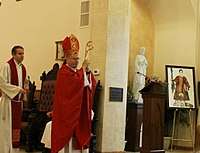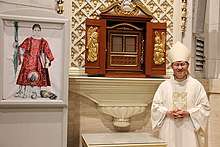Caesarius of Africa
| Saint Caesarius of Africa | |
|---|---|
|
| |
| Deacon and Martyr | |
| Died |
c. 3rd century Terracina, Italy |
| Venerated in | Roman Catholic Church |
| Major shrine | Terracina |
| Feast | 1 November |
| Attributes | palm, Gospel, sack |
| Patronage | patron saint of Roman emperors, has replaced and Christianized the cult of Julius Caesar and Augustus; invoked against drowning, flooding, and for the good success of Caesarean section. |
Saint Caesarius of Africa, also Caesarius of Terracina (Saint Cesario deacon in Italian) was a Christian martyr. The church of San Cesareo in Palatio in Rome bears his name.
Life
Caesarius was a deacon of Africa, martyred at Terracina in Italy.
The "Passio" (story of martyrdom) of Saint Caesarius is set in Terracina, harbor town near Rome and Naples, under the pagan emperor Trajan (r. 98-117).
Caesarius, a deacon from Carthage (belonging to the ancient and illustrious gens Julia), after a shipwreck, arrived in Terracina to preach the Gospel to poor people. In this Roman city, each year on the first day of January, a ceremony of self-immolation took place to assure the health and salvation of the Empire. A young man was pampered with material delights and fulfilled in all his wishes for eight months; then he was obliged to mount on a richly harnessed horse, climb up to the summit of city's cliff and throw himself into the void, with the recalcitrant horse, to crash against the rocks and perish in the waves in honour of the god Apollo, as an expiatory offering for the prosperity of the state and the emperors. The deacon Caesarius denounced this pagan custom and protested: "Alas for a state and emperors who persuade by tortures and are fattened on the outpouring of blood".[1]
The priest of Apollo, named Firminus, had him arrested and taken before to Leontius, Roman consul of Campania. During the interrogation, he refused to sacrifice to the pagan god of the sun and light, and his prayers caused the temple of Apollo to collapse (located in the Forum), killing the pagan Firminus. Caesarius was then locked up in jail and, after twenty-two months, he was taken to the Forum to be judged: he asked permission to pray: a radiant light blazed down on him, and the pagan consul Leontius was thereupon converted and sought baptism; he died shortly after (October 30).[2]
The 1st of November of the year 107 A.D., Luxurius, governor of the city, tied Caesarius and Julian (a local presbyter) up together in a sack, and flung them into the sea, from a cliff called "Pisco Montano".[3]
Nevertheless the deacon Caesarius was martyred, although not before prophesying the death of Luxurius, bitten by a poisonous viper.[4]
Caesarius and Julian, on that same day, were thrown back onto the shore, and were buried by Eusebius, a servant of God, near the town of Terracina.[5]
Cult: Caesarius as an Imperial Saint
His feast is held on 1 November.
In the 4th century, the Emperor Valentinian I's daughter was healed at his shrine.[6] The emperor then decided to move his relics from Terracina to Romeas a mark of royal favour. They were taken to a church on the Palatine Hill, and when they were later moved to a new church near the Appian Way which got the name San Cesareo in Palatio.
Terracina Cathedral (Cattedrale dei Santi Pietro e Cesareo) is dedicated to him and Saint Peter.
Caesarius of Terracina is the saint chosen for his name to replace and Christianize the pagan figure of Julius Caesar; then there is the Julian, associated with Saint Caesarius, in Italy, whose church at the Imperial palace on the Palatine in Rome, recorded from the seventh century, shows that the name was interpreted in terms of the imperial title that originated with Julius Caesar.[7] Caesarius of Terracina also achieved prominence because a church, the imperial chapel, was named after him by Valentinian III, an example of a saint with a suitable name being chosen as a patron. Caesarius was the obvious patron for the chapel of the Caesars.[8] Caesarius, however, also had more to offer to the Palatine than his apposite name. His legend fit impeccably into the symbolism of the Palatine, offering a forceful Christian commentary on the meaning of the empire. In Caesarius the Byzantine administration found a saint capable of Christianizing Rome's imperial core. Caesarius's passio, a Latin text, revolves around the good health or prosperity (salus) of the Roman Empire. The legend presents Caesarius's martyrdom as proof that the well-being of the state rests more solidly on Christian foundations than on its pagan past. His passio presents an elaborate and gruesome panorama of the pagan ritual that, so its audience is led to believe, once underpinned the imperial administration. In contrast to this senseless and impious bloodshed, Caesarius's martyrdom truly works for the imperial salus by bearing witness to God's truth; commemoration of him offers a means to perpetuate that prosperity.[9]
Caesarius is the patron saint of Caesarean sections.
Saint Caesarius is invoked against the floods of the rivers, the drownings (in memory of his martyrdom), for defense against lightning, from telluric and meteorological calamities.[10]
Relics
The relics of the Saint Caesarius deacon and martyr are preserved in the Basilica Santa Croce in Gerusalemme in Rome (basalt urn of high altar), in the Basilica of San Frediano of Lucca, Tuscany (urn with six bones), and in Terracina Cathedral (urn with two shins and a reliquary arm).
Saint Cesarius is venerated in St. Michael Church of Netcong, a borough in Morris County, New Jersey, United States . A bone fragment of Saint Cesarius is preserved in this church.[10] Other relics of Saint Caesarius deacon are preserved in Saint Anthony’s Chapel in Pittsburgh (Pennsylvania); in St. Martha Church in Morton Grove (Illinois); in St. Joseph Cathedral in Buffalo (New York), in the Shrine of the Holy Relics in Maria Stein (Ohio), and in Cathedral of the Immaculate Conception in Manila (Philippines).
An Arm Reliquary of Saint Caesarius is preserved in Kunstegewerbemuseum in Berlin.
During the Middle Ages, bone fragments of the saint were translated into England: in Glastonbury Abbey[11] (his relics are listed at Glastonbury in the mid-twelfth-century list of Hugh Candidus of Peterborough) and in Cathedral of Exeter.[12] Bone fragment of St. Caesarius (with the cartouche in Latin "S. Caesarii diac. m.") are preserved in Sancta Sanctorum of Roma, in Cathedral of Monreale (Palermo, Italy), in Treasury of the Collegiate of St. Peter and St. Alexander in the Museum of the Chapter of the Rectory of Aschaffenburg (Germany), in the Museum Frederic Marès of Barcelona; in the Museum de la Visitation, Moulins (France); in the Museum São Roque of Lisbon.
Illustrations life of Caesarius deacon and martyr
.jpg) Shipwreck of Saint Caesarius deacon in the city of Terracina.
Shipwreck of Saint Caesarius deacon in the city of Terracina..jpg) Preaching of Saints Caesarius deacon and Julian presbyter in Terracina.
Preaching of Saints Caesarius deacon and Julian presbyter in Terracina..jpg) Saint Caesarius deacon denounces human sacrifice in Terracina.
Saint Caesarius deacon denounces human sacrifice in Terracina..jpg) Saint Caesarius deacon destroys the Temple of Apollo in Terracina.
Saint Caesarius deacon destroys the Temple of Apollo in Terracina...jpg) Saint Caesarius deacon converts the Roman consul Leonzio.
Saint Caesarius deacon converts the Roman consul Leonzio. Martyrdom of Saints Caesarius deacon and Julian on "Pisco Montano" of Terracina: closed in a sack and thrown into the sea ("Poena cullei").
Martyrdom of Saints Caesarius deacon and Julian on "Pisco Montano" of Terracina: closed in a sack and thrown into the sea ("Poena cullei"). Finding of body of Saint Caesarius deacon in Terracina.
Finding of body of Saint Caesarius deacon in Terracina.
Gallery
 Relic of St. Caesarius deacon and martyr, Saint Anthony’s Chapel in Pittsburgh, Pennsylvania. In photo, Fr. James Orr
Relic of St. Caesarius deacon and martyr, Saint Anthony’s Chapel in Pittsburgh, Pennsylvania. In photo, Fr. James Orr Relic of St. Caesarius deacon and martyr, St. Michael's Church in Netcong, New Jersey. In photo, Bishop Arthur J. Serratelli
Relic of St. Caesarius deacon and martyr, St. Michael's Church in Netcong, New Jersey. In photo, Bishop Arthur J. Serratelli Bishop Richard J. Malone and Vic. Gen. Msgr. David S. Slubecky with the relics and the icon of Caesarius of Terracina, Cathedral of Buffalo (New York).
Bishop Richard J. Malone and Vic. Gen. Msgr. David S. Slubecky with the relics and the icon of Caesarius of Terracina, Cathedral of Buffalo (New York). Relic of St. Caesarius deacon and marty, Manila Cathedral (Philippines). In photo, cardinal Luis Antonio Tagle.
Relic of St. Caesarius deacon and marty, Manila Cathedral (Philippines). In photo, cardinal Luis Antonio Tagle..jpg) Relic of St. Caesarius deacon and martyr, St. Martha Church in Morton Grove (Illinois). In photo Father Dennis O'Neill and deacon John Herbert
Relic of St. Caesarius deacon and martyr, St. Martha Church in Morton Grove (Illinois). In photo Father Dennis O'Neill and deacon John Herbert Saint Caesarius in Glastonbury Abbey
Saint Caesarius in Glastonbury Abbey
Sources
- Specific
- ↑ De Smedt C. -Van Hoof G. - De Backer J., Acta sanctorum novembris, tomus I, Parisiis 1887
- ↑ Amore Agostino, Cesario e Giuliano, santi martiri di Terracina, in Bibliotheca Sanctorum, III, Città del Vaticano 1963, coll. 1154-1155
- ↑ Caesarius Diaconus, testi e illustrazioni di Giovanni Guida, [s.l.: s.n.], 2015
- ↑ Sabine Baring-Gould, The Lives of the Saints, 1, J. Hodges., 1877
- ↑ Thomas F. Head, Medieval Hagiography: An Anthology, Psychology Press, 2001
- ↑ S. G. A. Luff, The Christian's Guide to Rome, Fordham University Press, 1967
- ↑ The Mankind quarterly, volume 39, Cliveden Press, 1998
- ↑ Michael Perham, The communion of saints, Published for the Alcuin Club by S.P.C.K., 1980
- ↑ Maya Maskarinec, City of Saints: Rebuilding Rome in the Early Middle Ages, University of Pennsylvania Press, 2018
- 1 2 Ex ossibus S. Caesarii: Ricomposizione delle reliquie di San Cesario diacono e martire di Terracina, testi ed illustrazioni di Giovanni Guida, [s.l.: s.n.], 2017
- ↑ Carley James P., Riddy Felicity, Arthurian Literature XVI, Boydell & Brewer, 1998
- ↑ Conner Patrick W., Anglo-Saxon Exeter: A Tenth-century Cultural History, Boydell & Brewer Ltd, 1993